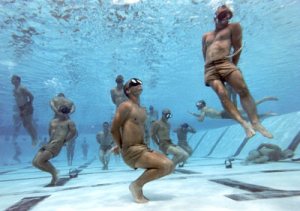 JOHN BOYD
JOHN BOYD
John Boyd was an American thinker. The fact that he was an Air Force Colonel beloved by Marines gives you some idea of what a paradoxical character he must have been. As 40 second Boyd, he was the fighter pilot instructor at Nellis Air Force Base who could wax the tail of any opponent in less than 40 seconds. As an engineer, he developed the Energy-Maneuverability theory, which for the first time allowed the flight characteristics and capabilities of existing aircraft to be compared and the performance of prospective designs to be predicted. When he “retired”, his cross-disciplinary studies led to three major breakthroughs: Destruction and Creation, the OODA Loop, and Patterns of Conflict a “brief” that took Boyd a minimum of five hours to deliver and changed modern American military strategy.
DESTRUCTION AND CREATION
DESTRUCTION AND CREATION is the foundation of Boyd’s theoretical work and it is this piece that I want to draw to your attention. Destruction and Creation deals with the creative process in a fundamental way. For Boyd, the creative process begins with an observation of existing domains (mental patterns or concepts of meaning). Domains are made up of constituent parts. If we shatter the correspondence between each domain and its individual parts, we can keep the parts and discard the domains. From this pile of parts, we can select and coordinate items that fit together to create a new domain (provided of course, that we don’t reassemble them in a fashion that merely recreates previous domains). Then, we test the new domain for soundness, as not all creative ideas are sound ideas when tested against observed reality.
Boyd used the following example as an illustration of destruction and creation, forging a new domain from constituent parts of existing domains.
IMAGINE:
You are on ski slope with other skiers — retain this image.
You are in Florida riding in an outboard motor boat – maybe even pulling water skiers — retain this image.
You are riding a bicycle on a nice Spring day — retain this image.
You are a parent taking your son to a department store and you notice he is fascinated by the toy tractors or tanks with rubber caterpillar treads — retain this image.
NOW IMAGINE THAT YOU:
Pull skis off ski slope; discard and forget rest of image.
Pull outboard motor out of motorboat; discard and forget rest of image.
Pull handlebars off bicycle; discard and forget rest of image.
Pull rubber treads off toy tractor or tanks; discard and forget rest of image.
THIS LEAVES US WITH
Skis, outboard motor, handlebars, rubber treads.
PULLING ALL THIS TOGETHER
What do we have?
 Photo by: branewphoto
Photo by: branewphoto
Examples from Physical Culture: MMA and CrossFit
The early days of MMA were a carnival freak show. It’s primary purpose was to promote the Gracie Brazilian Jiu Jitsu system by demonstrating that BJJ was superior to all other martial arts and hand to hand combat systems. In creating a forum where practitioners of different combat sports repeatedly pitted their skills against one another, inadvertently, the Gracies created an event which shattered the domains of traditional martial arts and combat sports.
Over a relatively short period of time, you could watch the weaknesses and strengths of various traditional arts being exposed, broken down into their constituent parts. The athletes added the skills, strategies, and training methods that were effective and ignored those that were ineffective. They synthesized new systems designed to make them more competitive. A new domain was born. MMA no longer refers to an event where a Judo practitioner competes against a Jiu Jitsu practitioner. In fact, now, this idea seems ridiculous. MMA is its own domain.
Over a similar time frame, CrossFit has had an impact on physical culture. The CrossFit approach breaks down various sports and associated training methods, then synthesizes workouts of the day which include aspects of callisthenics, resistance training, gymnastics training, Olympic lifting, sprinting, high intensity interval training, etc. The popularity of CrossFit has surged.
Observation and Instability
Boyd points out that even particularly stable domains are not perfectly consistent with observable reality. In fact, as we refine our observation, the mismatch becomes more glaring. To resolve the error (in our mental pattern), we resort to analyzing (un-structuring) various domains. Opening up these domains gives us the constituent parts needed to synthesize a new domain. As we test this new domain, our feedback will indicate whether or not our new mental pattern correlates well with observed reality. Low correlation patterns are discarded, as they are not useful. If there is a high correlation, then the domain is relatively stable and the mental pattern is useful. But, with further observation, even the slightest disparity between a particular domain and reality will lead to instability and the need to develop a new domain. Thus, as Boyd sees it, the process of Structure, Unstructure, Restructure, Unstructure repeats toward higher and broader levels of elaboration. This is an elegant idea, which I hope I haven’t damaged too badly by my description.
We can see that this process took place within MMA at a fairly rapid rate and has since slowed. At this point, slight modifications are being made, but in general, as a sport, this new domain is relatively stable. (Note: Outside of the domain of sport, MMA has some obvious weaknesses. If the goal is to visit violence on another human being, then MMA training is not the most efficient system for this. If the goal is to defend oneself against real world violence, then the MMA practitioner will face the same problem encountered by martial arts film-makers through the years: What does the hero do, when faced with a gun or multiple opponents?)
As the above process dictates, MMA as a domain will be unstructured again in the future and resynthesized in a new form. My prediction is that this will be the result of fans demanding more entertaining fights. Something similar happened in boxing in the late 19th century, with the move away from bare knuckles and the adoption of the Marquess of Queensberry rules. (Here the social impetus was a move away from the base desire simply to win toward a greater emphasis on the importance of playing by the rules.)
The unstructuring process for CrossFit is progressing more slowly. Part of this may be attributed to the fact that, at the higher levels, the community shuns those that question the methods within the domain. Consequently, key innovators leave the community to explore ideas outside of the CrossFit domain. Mark Twight, Mark Rippetoe, Dan John, Greg Everett, and Robb Wolf form a Who’s Who of notables with public splits from CrossFit HQ. Meanwhile, it remains unclear whether CrossFit meets their stated goal of providing broad general fitness, as questions frequently arise about whether the program does more harm than good. Think CrossFit induced rhabdomyolysis as the most publicized example. Remember, low correlation patterns will be discarded.
But, much as the Gracie’s inadvertently unstructured traditional martial arts, the CrossFit games may be the mechanism that kick-starts the process of unstructuring and restructuring CrossFit. To better compete at the games athletes are tearing the CrossFit domain and other training domains down to their constituent parts and synthesizing programs that correlate to success in competition. For practitioners and fans of CrossFit expect a new domain to emerge.
Control Mechanism
Boyd concludes Destruction and Creation by noting how this process oscillates between disorder and order. Unstructuring begins, because there is a recognized weakness in the current thought pattern as it relates to achieving a real world goal. Left unchecked, unstructuring leads to higher and higher levels of disorder. However, because achieving a particular goal requires increased order, there is a necessary shift away from analysis toward synthesis of a new system. This shift reverses the trend, away from disorder toward order. Paradoxically, then, an entropy increase permits both the destruction, or unstructuring, of a closed system and the creation of a new system to nullify the march toward randomness and death. For Boyd this paradox results in a harmony between destruction and creation that drives and regulates a dialectic engine. It is this engine that creates new mental patterns that allow us to shape and be shaped by our environment, whether that environment is on the mat, in the gym, or some other aspect of life.










